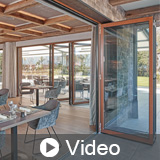
Clear Intentions: Integrating Operable Glass Walls for Resilient Design
At NanaWall, design is as much about how it looks as how it works. For over 35 years, we have been leading the industry in developing and refining our opening glass walls to create solutions that visually harmonize with space, transform the architectural experience, and provide decades of enduring performance.
Imagine seamlessly blending indoor environments with the natural world while achieving sustainability goals. Operable glass walls aren't just architectural elements, they're catalysts for transformation, offering design professionals a strategic advantage in pursuing LEED v4.1 BD+C and ID+C credits. These innovative systems provide interiors with natural light, frame stunning views, and create direct connections to nature, elements proven to enhance occupant well-being and lifestyle. Beyond these immediate benefits, operable glass walls serve as multifunctional solutions that elevate building performance on multiple fronts: reducing energy consumption through passive design strategies, creating adaptable acoustic environments that respond to changing needs, and contributing to material transparency initiatives and healthier indoor spaces.
Through case studies and best practices, design professionals will discover how to leverage these versatile systems to create spaces that meet sustainability targets.
- Explore how operable glass walls can help design professionals contribute to LEED v4.1 BD+C and ID+C credits and provide a beautiful, healthy space for building occupants.
- Discuss how operable glass walls can help contribute to LEED v4.1 BD+C and ID+C credits that focus on daylighting, views, and access to nature.
- Describe how operable glass walls can contribute to LEED v4.1 BD+C and ID+C credits that prioritize energy performance, acoustics, resilient design, and material transparency.
- Review best practices for specifying operable glass walls and examine case studies that illustrate the significant benefits owners, occupants, and design professionals can expect.





